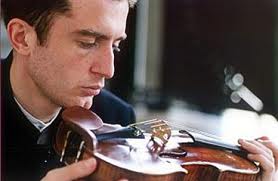|
Symphony
SRS SEASON ENDS WITH RESOUNDING TA-TA-TA-BANG
by Terry McNeill
Sunday, June 1, 2025
Symphony
YOUTHFUL VIRTUOSITY ON DISPLAY AT USO'S MAY CONCERTS
by Peter Lert
Saturday, May 17, 2025
Symphony
MYSTICAL PLANETS AND LIVELY GERSHWIN ORTIZ AT FINAL SRS CONCERT
by Peter Lert
Sunday, May 4, 2025
Symphony
VSO'S CONCERT MUSIC OF TIME, MUSIC OF PLACE
by Peter Lert
Sunday, April 27, 2025
Choral and Vocal
VOCAL ELEGANCE AND FIRE AT THE 222'S RECITAL APRIL 26
by Pamela Hicks Gailey
Saturday, April 26, 2025
CANTIAMO SONOMA SINGS AN INSPIRED GOOD FRIDAY MOZART REQUIEM CONCERT
by Pamela Hicks Gailey
Friday, April 18, 2025
DRAMATIC SHOSTAKOVICH SYMPHONY CLOSES PHILHARMONIC'S 25TH SEASON
by Terry McNeill
Sunday, April 13, 2025
LARGE COLLEGE OF MARIN AUDIENCE GREETS STOPHER ARTISTRY
by Terry McNeill
Saturday, April 5, 2025
Chamber
FRISSON DELIVERS SHIVERS OF DELIGHT
by Abby Wasserman
Sunday, March 30, 2025
OLD AND MOSTLY NEW IN SRS MARCH CONCERT IN WEILL
by Peter Lert
Saturday, March 22, 2025
|
 |
 Violinist Tedi Paparvrami |
FOUR-SQUARE AND FORMIDABLE
by Steve Osborn
Sunday, October 6, 2013
Perhaps the four syllables of Dmitri Shostakovich's last name are what inspired him to write so many works in four movements, with a predilection for 4/4 time. Two of those works were on sonic display Oct. 6 at the Santa Rosa Symphony's opening concert set: his Symphony No. 5, with the customary four movements, and his violin concerto, with an unusual four instead of the standard three. The contents of these works are mostly four-square, both rhythmically and melodically, as exemplified by the four-note theme in the concerto that spells out the composer's abbreviated name.
What this abundance of fours does is to make for satisfying, crowd-pleasing music that runs the gamut of human emotions within a well-defined frame. The performance in this case was exceptional, with stupendous work from violin soloist Tedi Papavrami and inspired playing by the orchestra under Music Director Bruno Ferrandis.
Papavrami is an ideal candidate for the four-loving, quadraphilic Shostakovich. Clad entirely in black, with a dead-serious expression at all times, he resembles a boxer negotiating a four-square ring. His customary stance--knees bent, feet shoulder-width apart, hands up, ready to punch--is the essence of pugilism. Undeterred by the laws of physics governing human fingers, he delivers nothing but knockouts.
Playing a modern violin by the Lisbon-based Christian Bayon, Papavrami filled Weill Hall to overflowing with lush, liquid sound. The languorous opening movement of the concerto--a Nocturne--was a perfect foil for his gorgeous tone and lapidary technique. Every aspect of his playing was well controlled, from the vibrato to the double stops to the razor-sharp intonation in the upper registers. As the Nocturne progressed, the sound became shimmering and iridescent, hovering over the audience like a gentle rain.
Shattering the calm, Papavrami drove relentlessly into the Scherzo second movement, holding his own in a series of intimidating syncopations, and striking chords with machine-like precision. The orchestra kept pace, ending with a dramatic crescendo. The third frame--a Passacaglia--was both stately and majestic, punctuated by occasional blasts from the tuba. The pacing evoked a long march over a challenging landscape, and toward the end Papavrami's lower strings really began to resonate. This led to a long cadenza marked by complete silence in the hall as Papavrami coaxed more and more sound out of his instrument, featuring (what else?) four-note clusters followed by full chords and lightning runs.
Papavrami could have retired from the ring after the cadenza, but he went one more round with the final Burlesque, displaying incredible energy as he dashed off its many virtuosic passages. The ovation at the end was instantaneous and sustained, but sadly did not lead to a solo encore.
An encore of sorts did arrive in the second half, as the orchestra trotted out to play more Shostakovich, this time his popular Symphony No. 5. This modern masterpiece is definitely a Fifth Symphony, with a clear nod to Beethoven in the opening phrase. The strings had a particularly clean sound, with remarkable unanimity and a full, rich bass. The image of the march emerged once again in the opening movement, reinforced by the percussion, a gradual acceleration, and then a heroic unison that found Ferrandis jumping up and down on the podium. Turning on a dime, the orchestra ended tenderly, with a wonderful solo from concertmaster Joseph Edelberg.
The Allegretto second movement is one of Shostakovich's best-known works, and its dancing 3/4 rhythm stands in stark contrast to the rest of the symphony. Ferrandis responded well to the change in mood, evoking a lilting pace with restrained motions. The mood changed once again with the ensuing Largo, perhaps the most heartfelt music of the afternoon. The oboe solo over violin tremolo was outstanding, and the feeling projected throughout the movement was sublime, sustained all the way to the final resolving chord.
The exact opposite prevailed in the concluding Allegro. The trumpets blared out the rollicking theme, and then controlled mayhem ensued, with the orchestra regularly rising to triple forte. Timpanist Andrew Lewis was particularly fun to watch, as he held his mallets gleefully in the air, preparing for the next thundering descent. An authoritative boom from the bass drum brought the proceedings to a close.
Lest the reader think that the Santa Rosa Symphony plays only Shostakovich, the concert did begin with John Adams' iconic "Short Ride in a Fast Machine," now almost 30 years old. This too was four-square in its fashion, actually more four-geared, as the orchestra shifted rapidly from one layer of sound to the next. This thrilling piece, which helped bring Minimalism into the mainstream, sounds somewhat tame these days, prompting the elderly patron next to me to remark to her companion, "I actually sort of liked it."
|
